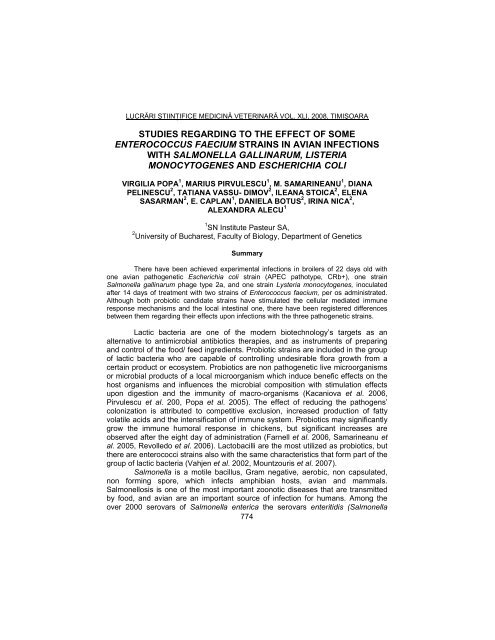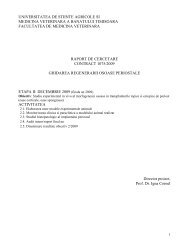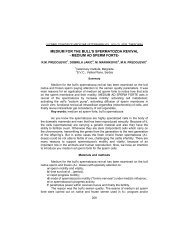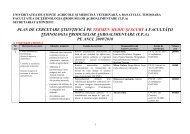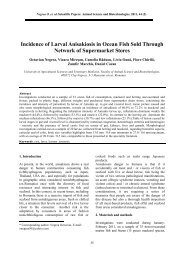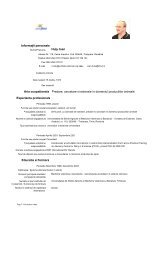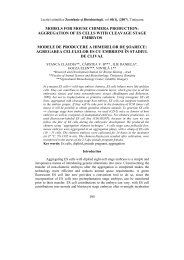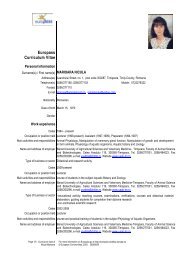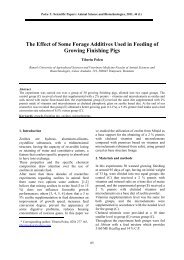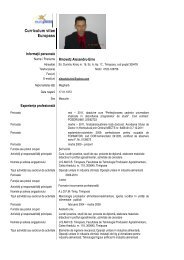studies regarding to the effect of some enterococcus faecium strains ...
studies regarding to the effect of some enterococcus faecium strains ...
studies regarding to the effect of some enterococcus faecium strains ...
You also want an ePaper? Increase the reach of your titles
YUMPU automatically turns print PDFs into web optimized ePapers that Google loves.
LUCRĂRI ŞTIINłIFICE MEDICINĂ VETERINARĂ VOL. XLI, 2008, TIMIŞOARA<br />
STUDIES REGARDING TO THE EFFECT OF SOME<br />
ENTEROCOCCUS FAECIUM STRAINS IN AVIAN INFECTIONS<br />
WITH SALMONELLA GALLINARUM, LISTERIA<br />
MONOCYTOGENES AND ESCHERICHIA COLI<br />
VIRGILIA POPA 1 , MARIUS PIRVULESCU 1 , M. SAMARINEANU 1 , DIANA<br />
PELINESCU 2 , TATIANA VASSU- DIMOV 2 , ILEANA STOICA 2 , ELENA<br />
SASARMAN 2 , E. CAPLAN 1 , DANIELA BOTUS 2 , IRINA NICA 2 ,<br />
ALEXANDRA ALECU 1<br />
1 SN Institute Pasteur SA,<br />
2 University <strong>of</strong> Bucharest, Faculty <strong>of</strong> Biology, Department <strong>of</strong> Genetics<br />
Summary<br />
There have been achieved experimental infections in broilers <strong>of</strong> 22 days old with<br />
one avian pathogenetic Escherichia coli strain (APEC pathotype, CRb+), one strain<br />
Salmonella gallinarum phage type 2a, and one strain Lysteria monocy<strong>to</strong>genes, inoculated<br />
after 14 days <strong>of</strong> treatment with two <strong>strains</strong> <strong>of</strong> Enterococcus <strong>faecium</strong>, per os administrated.<br />
Although both probiotic candidate <strong>strains</strong> have stimulated <strong>the</strong> cellular mediated immune<br />
response mechanisms and <strong>the</strong> local intestinal one, <strong>the</strong>re have been registered differences<br />
between <strong>the</strong>m <strong>regarding</strong> <strong>the</strong>ir <strong>effect</strong>s upon infections with <strong>the</strong> three pathogenetic <strong>strains</strong>.<br />
Lactic bacteria are one <strong>of</strong> <strong>the</strong> modern biotechnology’s targets as an<br />
alternative <strong>to</strong> antimicrobial antibiotics <strong>the</strong>rapies, and as instruments <strong>of</strong> preparing<br />
and control <strong>of</strong> <strong>the</strong> food/ feed ingredients. Probiotic <strong>strains</strong> are included in <strong>the</strong> group<br />
<strong>of</strong> lactic bacteria who are capable <strong>of</strong> controlling undesirable flora growth from a<br />
certain product or ecosystem. Probiotics are non pathogenetic live microorganisms<br />
or microbial products <strong>of</strong> a local microorganism which induce benefic <strong>effect</strong>s on <strong>the</strong><br />
host organisms and influences <strong>the</strong> microbial composition with stimulation <strong>effect</strong>s<br />
upon digestion and <strong>the</strong> immunity <strong>of</strong> macro-organisms (Kacaniova et al. 2006,<br />
Pirvulescu et al. 200, Popa et al. 2005). The <strong>effect</strong> <strong>of</strong> reducing <strong>the</strong> pathogens’<br />
colonization is attributed <strong>to</strong> competitive exclusion, increased production <strong>of</strong> fatty<br />
volatile acids and <strong>the</strong> intensification <strong>of</strong> immune system. Probiotics may significantly<br />
grow <strong>the</strong> immune humoral response in chickens, but significant increases are<br />
observed after <strong>the</strong> eight day <strong>of</strong> administration (Farnell et al. 2006, Samarineanu et<br />
al. 2005, Revolledo et al. 2006). Lac<strong>to</strong>bacilli are <strong>the</strong> most utilized as probiotics, but<br />
<strong>the</strong>re are enterococci <strong>strains</strong> also with <strong>the</strong> same characteristics that form part <strong>of</strong> <strong>the</strong><br />
group <strong>of</strong> lactic bacteria (Vahjen et al. 2002, Mountzouris et al. 2007).<br />
Salmonella is a motile bacillus, Gram negative, aerobic, non capsulated,<br />
non forming spore, which infects amphibian hosts, avian and mammals.<br />
Salmonellosis is one <strong>of</strong> <strong>the</strong> most important zoonotic diseases that are transmitted<br />
by food, and avian are an important source <strong>of</strong> infection for humans. Among <strong>the</strong><br />
over 2000 serovars <strong>of</strong> Salmonella enterica <strong>the</strong> serovars enteritidis (Salmonella<br />
774
LUCRĂRI ŞTIINłIFICE MEDICINĂ VETERINARĂ VOL. XLI, 2008, TIMIŞOARA<br />
enteritidis) and typhimurium (Salmonella typhimurium) are responsible for <strong>the</strong><br />
majority <strong>of</strong> enteritis <strong>of</strong> food origin in humans. Along <strong>the</strong> time, numerous strategies<br />
were applied for reducing Salmonella contamination in poultry farms destined for<br />
food industry (antibiotics, chemical nutritive supplements, competitive exclusion<br />
with non pathogenetic bacteria, genetic selection <strong>of</strong> chicken lines for an improved<br />
immune response and developing anti-salmonella vaccines). Infection with<br />
Salmonella enterica unleashes at chickens both humoral immune and cellular<br />
mediated responses. Immunoglobulin G, IgA and IgM produced in intestinal<br />
membrane and serum, CD4+T and IgG+ B spleen cells register high levels during<br />
<strong>the</strong> experimental infection with Salmonella (Avila et al.2006, Johannsen et al.2004,<br />
Orlic et al.2002). Low levels <strong>of</strong> CD8+T were registered in caecal <strong>to</strong>nsils after<br />
primary infection, but not also after <strong>the</strong> secondary. Salmonella gallinarum is one <strong>of</strong><br />
<strong>the</strong> non motile serovars <strong>of</strong> Salmonella specific for avian, that produces extremely<br />
important economical losses; in humans it can be found in certain conditions and<br />
rarely (immunocompromised beings). S. gallinarum is closely related antigenic with<br />
S. enteritidis, except with <strong>the</strong> absence <strong>of</strong> flagella antigens.<br />
Listeria monocy<strong>to</strong>genes is one pathogen widely spread in nature,<br />
unpretentious, it grows at refrigeration temperatures, and may form and coexist in<br />
bi<strong>of</strong>ilms. It is very persistent and may be a contaminant <strong>of</strong> food products.<br />
Decontamination in case <strong>of</strong> its presence represents an especial challenge because<br />
when it forms part <strong>of</strong> a bi<strong>of</strong>ilm Listeria sp. is protected against disinfectants. In<br />
avian pathology, respira<strong>to</strong>ry and joint affections especially in turkey due <strong>to</strong> L.<br />
monocy<strong>to</strong>genes, are more frequent (Zhao et al.2006, Huff et al.2005).<br />
Escherichia coli is present in <strong>the</strong> digestive tract <strong>of</strong> animals and humans.<br />
Natural infections in animals and humans, generically named colibacillosis, are<br />
characterized by: most <strong>of</strong> <strong>the</strong> cases, <strong>the</strong>y have <strong>the</strong> aspect <strong>of</strong> <strong>some</strong> enteropathies,<br />
<strong>some</strong>times <strong>the</strong>y have septicaemia character or <strong>of</strong> infections with o<strong>the</strong>r localizations;<br />
<strong>the</strong>y are infections conditioned by predisposed fac<strong>to</strong>rs, especially food and hygiene<br />
fac<strong>to</strong>rs; <strong>the</strong>y are severe, especially for young population, where it has<br />
septicaemical forms with enzootic evolution, producing important economical<br />
losses. E. coli <strong>strains</strong> are classified in various pathotypes, considering virulence<br />
fac<strong>to</strong>rs, and <strong>the</strong> infections that <strong>the</strong>y induce; those specific for avian are included in<br />
APEC pathotype (avian pathogenetic E. coli). APEC <strong>strains</strong> induce septicaemical<br />
infections, primery respira<strong>to</strong>ry, and are frequently characterized, those <strong>of</strong> serotype<br />
1, by <strong>the</strong> capacity <strong>of</strong> Congo Red dye binding (CRb+), culturally determined on TSA<br />
agar with Congo Red ( Popa et al.2005).<br />
The purpose <strong>of</strong> this study was <strong>to</strong> evaluate GM8 and VL43 Enterococcus<br />
<strong>faecium</strong> <strong>strains</strong> as potential probiotic <strong>strains</strong>, by studying <strong>the</strong>ir in vivo <strong>effect</strong>s in<br />
experimental infections with one Salmonella gallinarum 2a phage type strain, one<br />
APEC Escherichia coli strain, and one Lysteria monocy<strong>to</strong>genes strain, using as<br />
host broilers aged <strong>of</strong> 8 days old.<br />
775
LUCRĂRI ŞTIINłIFICE MEDICINĂ VETERINARĂ VOL. XLI, 2008, TIMIŞOARA<br />
Materials and methods<br />
Experimental design: 45 Cobb 500 broilers <strong>of</strong> 8 days old were used,<br />
acquired from an industrial farm; <strong>the</strong> bacteriological controls for <strong>the</strong> presence <strong>of</strong> E.<br />
coli- APEC pathogen for avian, Salmonella or Lysteria spp., were negative. Broilers<br />
were marked and randomly distributed in nine groups: group A: control (n= 5);<br />
group B: Enterococcus <strong>faecium</strong> GM8 + Escherichia coli APEC (n= 5); group C:<br />
Enterococcus <strong>faecium</strong> VL43 + Escherichia coli APEC (n=5); group D: Escherichia<br />
coli APEC 4293 (n=5); group E: Enterococcus <strong>faecium</strong> GM8 + Salmonella<br />
gallinarum 2a 91( n=5); group F: Enterococcus <strong>faecium</strong> VL43 + Salmonella<br />
gallinarum 2a 91(n=5); group G: Salmonella gallinarum 2a 91 (n=5); group H:<br />
Enterococcus <strong>faecium</strong> VL43 + Listeria monocy<strong>to</strong>genes (n=5); group I: Listeria<br />
monocy<strong>to</strong>genes (n=5). Broilers were foddered ad libitum, and <strong>the</strong> feed recipe was<br />
in concordance <strong>to</strong> <strong>the</strong>ir age (Grower, 21-1G), without coccidiostatic (produced and<br />
commercialized by IBNA); administration <strong>of</strong> drinking water was also ad libitum.<br />
Daily, during 15 days, five groups <strong>of</strong> chicken were orally inoculated with<br />
Enterococcus <strong>faecium</strong> GM8 (B, E), respectively Enterococcus <strong>faecium</strong> VL43 (C, F,<br />
H), in doses <strong>of</strong> 1 ml/ chicken, <strong>of</strong> integral culture (BHI, 18 hours age culture, 37ºC;<br />
except during <strong>the</strong> week-end/ first day <strong>of</strong> <strong>the</strong> week, <strong>the</strong>re were used <strong>the</strong> 42/ 66/ 90<br />
hours culture). Pathogenetic <strong>strains</strong> <strong>of</strong> Escherichia coli APEC, Salmonella<br />
gallinarum, phage type 2a, isolate 91, and Listeria monocy<strong>to</strong>genes were orally<br />
inoculated (syringe without needle), as integral 18h age culture obtained static in<br />
BHI, in aerobic conditions, at 37ºC, in <strong>the</strong> 14 th day <strong>of</strong> <strong>the</strong> experiments, in doses <strong>of</strong> 1<br />
ml/ chicken.<br />
At <strong>the</strong> end <strong>of</strong> <strong>the</strong> experiment, for <strong>the</strong> bacteriologic control <strong>regarding</strong> <strong>to</strong> <strong>the</strong><br />
presence/ reisolation/ translocation in <strong>the</strong> organism <strong>of</strong> inoculated <strong>strains</strong> and for<br />
his<strong>to</strong>logical exams, organ samples were harvested (<strong>the</strong> small intestine, ileumcaecum<br />
junction, liver, spleen, lung) from all groups <strong>of</strong> chickens. At <strong>the</strong> age <strong>of</strong> 35<br />
days (end <strong>of</strong> <strong>the</strong> experiment), blood samples were harvested on anticoagulant for<br />
control tests <strong>regarding</strong> <strong>to</strong> <strong>the</strong> cellular immunity. All chickens (n=45) were<br />
slaughtered at <strong>the</strong> age <strong>of</strong> 35 days (28 days <strong>of</strong> experiment).<br />
His<strong>to</strong>logy: Organ samples (intestine, lever, spleen) harvested at slaughter,<br />
were fixed in Baker formaldehyde, included in Paraplast+ (Sigma), sectioned at <strong>the</strong><br />
thickness <strong>of</strong> 5 µm, stained by HEA tricolor method (Masson) and examined at <strong>the</strong><br />
optic microscope.<br />
Bacteriology: Probiotic candidate <strong>strains</strong> used in this study were isolated<br />
and selected after previous evaluations/ experiments achieved by <strong>the</strong> team <strong>of</strong> Pr<strong>of</strong>.<br />
Dr. Tatiana Vassu, Faculty <strong>of</strong> Biology, and University <strong>of</strong> Bucharest. The inoculum<br />
administrated at five from <strong>the</strong> nine groups <strong>of</strong> chickens was constituted <strong>of</strong> <strong>the</strong> two<br />
<strong>strains</strong> <strong>of</strong> Enterococcus <strong>faecium</strong> GM8 and VL43, as 18 h age integral culture, static<br />
obtained in aerobic conditions, at 37ºC, in BHI (Pasteur, McF 4.8- 5.3, respectively<br />
5.4- 6.3). Pathogenetic strain <strong>of</strong> Escherichia coli APEC and Salmonella gallinarum<br />
phage type 2a isolate 91, <strong>of</strong> avian origin, isolated from poultry farms from Romania,<br />
776
LUCRĂRI ŞTIINłIFICE MEDICINĂ VETERINARĂ VOL. XLI, 2008, TIMIŞOARA<br />
and <strong>the</strong> strain Listeria monocy<strong>to</strong>genes, <strong>of</strong> American origin, come from Pasteur<br />
Institute’s collection. Bacteriological exams for control/ detection/ recovery <strong>of</strong><br />
inoculated <strong>strains</strong> were achieved in <strong>the</strong> same conditions <strong>of</strong> cultivation. Identification<br />
<strong>of</strong> isolates- recovered <strong>strains</strong>/ control <strong>of</strong> <strong>the</strong> identity <strong>of</strong> <strong>the</strong> inocula used in in vivo<br />
experiments was performed by biochemical tests on API20STREP or Rapid ID32<br />
galleries, for <strong>the</strong> Enterococcus <strong>faecium</strong> <strong>strains</strong>, and ApiListeria (BioMerieux), for<br />
Listeria monocy<strong>to</strong>genes, with interpretation according <strong>to</strong> <strong>the</strong> logic s<strong>of</strong>tware APILAB<br />
( BioMerieux). Recording bacterial colonies on <strong>the</strong> media used has been codified<br />
accordingly <strong>to</strong> <strong>the</strong> scale: presence – 1, absence – 0 (with log10 graphic<br />
expression). The inoculum’s titration was achieved by <strong>the</strong> method <strong>of</strong> dilutions on<br />
solid mediua (Pasteur) and by using densi<strong>to</strong>metry (Densimat, BioMerieux;<br />
McFarland units – McF). Titration <strong>of</strong> <strong>the</strong> inoculum (determination <strong>of</strong> UFC/ml), was<br />
achieved by dilutions in PBS and dispersions on agar Columbia (Oxoid) + 5%<br />
sheep defibrinated blood (for Enterococcus spp), MacConkey agar (for Escherichia<br />
coli and Salmonella gallinarum) and TSA agar+ 5% sheep defibrinated blood (I.<br />
Pasteur, 10 mcl/ plate), from 18 hour old culture in BHI. For recovering and<br />
evaluation <strong>of</strong> <strong>the</strong> Escherichia coli APEC load, <strong>the</strong> determination <strong>of</strong> ufc was<br />
achieved with PBS used for inside washing <strong>of</strong> <strong>the</strong> carcass and <strong>the</strong>n by dilutions in<br />
PBS and dispersions on MacConkey agar; qualitative recovery was achieved by<br />
direct isolation from lung by inseminations in BHI and dispersion on TSA + Congo<br />
Red 0.3% (character <strong>of</strong> CRb+ as marker <strong>of</strong> <strong>the</strong> strain). For <strong>the</strong> recovery and<br />
evaluation <strong>of</strong> Salmonella gallinarum load, <strong>the</strong> determination <strong>of</strong> ufc was achieved by<br />
suspending 0.25 g <strong>of</strong> excrements in 2.25 ml <strong>of</strong> PBS and than by dilutions in PBS<br />
and dispersions on MacConkey agar; qualitative recovery was achieved by direct<br />
isolation from faeces, spleen and caecal <strong>to</strong>nsils by inseminations in Na Selenite<br />
and dispersion on MacConkey Agar For <strong>the</strong> recovery and evaluation <strong>of</strong> <strong>the</strong> load <strong>of</strong><br />
Listeria monocy<strong>to</strong>genes, determination <strong>of</strong> ufc was achieved with PBS used for<br />
washing articular cavities and than by dilutions in PBS and dispersions on agar<br />
TSA + 5% sheep defibrinated blood; qualitative recovery was achieved by<br />
inseminations in BHI directly from articular cavities.<br />
Immunology: Cellular immunity was evaluated by <strong>the</strong> test <strong>of</strong> blastic<br />
transformation <strong>of</strong> lymphocytes. Shortly: in case <strong>of</strong> each chicken controlled by this<br />
test (age 35 days, at <strong>the</strong> end <strong>of</strong> <strong>the</strong> experiment, previous <strong>to</strong> slaughter), <strong>the</strong> quantity<br />
<strong>of</strong> 0.3 ml <strong>of</strong> blood was inoculated in 3 ml <strong>of</strong> RPMI1640 medium supplemented with<br />
7.5% bovine fetal serum and gentamicine (100 µg/ ml). Cellular stimulation was<br />
achieved with PHA-M 30µg/ml medium, respectively inactivated culture from each<br />
pathogen bacterial strain, and <strong>the</strong> negative control was constituted from<br />
unstimulated culture, in case <strong>of</strong> each blood sample analysed. The response <strong>of</strong> <strong>the</strong><br />
lymphocytes was evaluated by dosing residual glucose (ortho- <strong>to</strong>luidine) and <strong>the</strong><br />
index <strong>of</strong> stimulation was established by reporting <strong>the</strong> optic density values (read at<br />
610 nm) for <strong>the</strong> stimulated sample at <strong>the</strong> suitable negative control (non stimulated<br />
variant).<br />
777
LUCRĂRI ŞTIINłIFICE MEDICINĂ VETERINARĂ VOL. XLI, 2008, TIMIŞOARA<br />
Information analysis was achieved by ANOVA (MSExcel) and Chi 2<br />
(InStat, GraphPad S<strong>of</strong>tware 2.0).<br />
Results and discussions<br />
There were observed clinical discrete signs <strong>of</strong> inappetence during <strong>the</strong><br />
experiment, at a few days after inoculation <strong>of</strong> pathogen <strong>strains</strong>. At slaughter <strong>the</strong>re<br />
were observed ana<strong>to</strong>mical- pathological modifications <strong>of</strong> septicaemical type at<br />
<strong>the</strong> groups inoculated with <strong>the</strong> pathogenetic <strong>strains</strong>. Some <strong>of</strong> <strong>the</strong> results <strong>of</strong> <strong>the</strong><br />
his<strong>to</strong>logical exam are illustrated in <strong>the</strong> figures 3- 5. Ileum: At all <strong>the</strong> examined<br />
avian <strong>the</strong> villosities presented a normal aspect with numerous cup-shaped cells. In<br />
<strong>the</strong> submucous membrane <strong>the</strong>re were seen numerous glands with normal cells <strong>of</strong><br />
<strong>the</strong> glandular epi<strong>the</strong>lium. The simple prismatic epi<strong>the</strong>lium covers <strong>the</strong> intestinal<br />
villosities and goes down in <strong>the</strong> Lieberkühn vaults whose lumen it lines. There were<br />
remarked many non regular disseminated cup-shaped cells that alternate with<br />
absorptive epi<strong>the</strong>lial cells. The examined subjects have presented <strong>the</strong> lymphoid<br />
tissue hyperplasia with <strong>the</strong> compartment <strong>of</strong> Peyer patches developed, without<br />
germinal center, with different intensities. The chicken from groups E, F and H<br />
presented a medium immune reaction, manifested by hyperplasia with<br />
lymphoblasts in Peyer paches and in <strong>the</strong> diffuse lymphoid system. There was seen<br />
also a number <strong>of</strong> mi<strong>to</strong>tic figures. The most intense immune reaction was revealed<br />
at group H (Enterococcus <strong>faecium</strong> VL43 + Listeria monocy<strong>to</strong>genes). Spleen, at all<br />
<strong>the</strong> examined cases presented numerous lymphoid nodules, with lymphocytic<br />
crown medium developed and aspects <strong>of</strong> proliferation <strong>of</strong> <strong>some</strong> periarteriolar<br />
lymphoid sheath. In numerous nodules <strong>the</strong>re were observed medium intensity<br />
mi<strong>to</strong>sis. Reticulohys<strong>to</strong>cyte cells emphasized a discrete proliferation, and <strong>the</strong><br />
sinuses appeared <strong>to</strong> be dilated, with <strong>the</strong> presence <strong>of</strong> numerous spleenocytes inside<br />
<strong>the</strong> lumen; low intensity hyperemia inside <strong>the</strong> white pulp. The arteriolar endo<strong>the</strong>lium<br />
presented an intense hyperplasia. The subjects from groups E, F and H have<br />
expressed immune reactions <strong>of</strong> higher intensity compared with <strong>the</strong> chicken from<br />
groups B, C, D, G, I and controls (group A) characterized by lymphocytes<br />
hyperplasia in <strong>the</strong> B-dependent arias from lymphoid nodules and <strong>of</strong> <strong>the</strong> cells from<br />
T- dependent arias (periarteriolar). There was observed hyperplasia with high<br />
intensity lymphoblasts.<br />
The liver presented at all <strong>the</strong> examined birds normal aspects, except for<br />
<strong>the</strong> subjects from group E, that revealed hyperemia, biliary ducts with dilated lumen<br />
and fes<strong>to</strong>oned epi<strong>the</strong>lium; paucicellular hepa<strong>to</strong>cytar acidophilic necrosis. All <strong>the</strong><br />
subjects examined revealed <strong>the</strong> presence <strong>of</strong> <strong>some</strong> lymphocytes nodules,<br />
presenting an intralobular disposal <strong>of</strong> higher intensity in groups E and F<br />
(Enterococcus <strong>faecium</strong> GM8+ Salmonella gallinarum, respectively Enterococcus<br />
<strong>faecium</strong> VL43+ Salmonella gallinarum).<br />
The results <strong>of</strong> <strong>the</strong> bacteriological exams are graphically illustrated in<br />
figure 1, based on <strong>the</strong> log10 value <strong>of</strong> <strong>the</strong> registered score. At bacteriological<br />
778
LUCRĂRI ŞTIINłIFICE MEDICINĂ VETERINARĂ VOL. XLI, 2008, TIMIŞOARA<br />
controls in case <strong>of</strong> infection with Escherichia coli APEC <strong>the</strong>re were registered<br />
contradic<strong>to</strong>ry aspects: <strong>the</strong> Enterococcus <strong>faecium</strong> GM8 strain inhibited <strong>the</strong><br />
generalized translocation <strong>of</strong> <strong>the</strong> strain in <strong>to</strong> <strong>the</strong> organism, but not <strong>the</strong> colonization in<br />
<strong>the</strong> lung, compared with <strong>the</strong> Enterococcus <strong>faecium</strong> VL43 strain which seems <strong>to</strong><br />
have augmented/ maintained/ favourized <strong>the</strong> generalized colonization <strong>of</strong> <strong>the</strong><br />
pathogenetic strain. In case <strong>of</strong> Salmonella gallinarum infection <strong>the</strong> presence /<br />
translocation from intestine <strong>to</strong> spleen/ liver <strong>of</strong> <strong>the</strong> inoculated strain was inhibited by<br />
both Enterococcus <strong>faecium</strong> strain; between <strong>the</strong> two <strong>strains</strong> <strong>of</strong> Enterococcus<br />
<strong>faecium</strong> <strong>the</strong>re were registered differences, with an advantage for GM8 strain. In<br />
case <strong>of</strong> infection with Listeria <strong>the</strong>re were also registered results <strong>some</strong>how<br />
paradoxically in <strong>the</strong> sense <strong>of</strong> that <strong>the</strong> Enterococcus <strong>faecium</strong> VL43 strain seemed <strong>to</strong><br />
have encouraged <strong>the</strong> articular colonization <strong>of</strong> Listeria strain.<br />
The results <strong>of</strong> <strong>the</strong> lymphocytes’ blastic transformation test <strong>regarding</strong> <strong>to</strong> <strong>the</strong><br />
cellular immunity are graphically illustrated in figure 2. The same as in <strong>the</strong> case <strong>of</strong><br />
bacteriological results, <strong>the</strong> results were slightly paradoxical, <strong>the</strong>re were not been<br />
registered statistically significant differences between groups, but <strong>the</strong> medium<br />
lymphocyte response <strong>of</strong> <strong>the</strong> groups inoculated with lactic bacteria <strong>to</strong>wards <strong>the</strong><br />
stimulation with antigens derived from pathogenetic <strong>strains</strong> was influenced by <strong>the</strong><br />
quantity <strong>of</strong> antigen, and <strong>the</strong> non specific response tested for PHA was high at <strong>the</strong><br />
group inoculated with Enterococcus <strong>faecium</strong> VL43 and Escherichia coli and for <strong>the</strong><br />
group inoculated with Salmonella gallinarum and Enterococcus <strong>faecium</strong> GM8.<br />
Conclusions<br />
1. Enterococcus <strong>faecium</strong> GM8 <strong>strains</strong> and Enterococcus <strong>faecium</strong> VL43,<br />
administrated daily for 15 days <strong>to</strong> broilers Cobb500 influenced <strong>the</strong> immune<br />
response <strong>to</strong> <strong>the</strong> pathogenetic bacterial <strong>strains</strong> administrated in <strong>the</strong> 14 th day <strong>of</strong> <strong>the</strong><br />
experiments.<br />
2. His<strong>to</strong>pathological exams <strong>of</strong> lymphoid organs demonstrated a more<br />
intense immune response at <strong>the</strong> level <strong>of</strong> ileum and spleen (groups E, F and H)<br />
compared with <strong>the</strong> cases from group A (control); morphological identification at <strong>the</strong><br />
level <strong>of</strong> <strong>the</strong> ileum <strong>of</strong> lymphocytes’ hyperplasia, localized in Peyer patches and<br />
diffuse, and also at <strong>the</strong> level <strong>of</strong> <strong>the</strong> spleen, and at <strong>the</strong> level <strong>of</strong> <strong>the</strong> lymphocytes<br />
situated in <strong>the</strong> malpighian corpuscles (regions B- dependent) and <strong>of</strong> <strong>the</strong><br />
periarteriolar lymphocitar sheath (arias B- dependent), demonstrated <strong>the</strong> fact that<br />
an immune cellular response, induced by <strong>the</strong> immunogenes used, was installed.<br />
3. Also, <strong>the</strong> treatment with <strong>the</strong> two lactic bacterial <strong>strains</strong> induced an<br />
activation <strong>of</strong> <strong>the</strong> cellular mediated immune response and <strong>of</strong> <strong>the</strong> local response,<br />
from <strong>the</strong> level <strong>of</strong> <strong>the</strong> intestine.<br />
779
LUCRĂRI ŞTIINłIFICE MEDICINĂ VETERINARĂ VOL. XLI, 2008, TIMIŞOARA<br />
Acknowledgments<br />
This study was financed by Romanian Ministry <strong>of</strong> Education, Research and<br />
Youth, through <strong>the</strong> contract CEEX Biotech 3-9/ 2005).<br />
References<br />
1. Avila L. A. F., V. P. Nascimen<strong>to</strong>, C. T. P. Salle, H. L. S. Morales 2006,<br />
Effects <strong>of</strong> Probiotics and Maternal Vaccination on Salmonella Enteritidis<br />
Infection in Broiler Chicks, Avian diseases 50:608–612<br />
2. Farnell M. B., A. M. Donoghue, F. Solis De Los San<strong>to</strong>s, P. J. BLORE,B.<br />
M. Hargis, G. Tellez, D. J. Donoghue 2006, Upregulation <strong>of</strong> Oxidative Burst<br />
and Degranulation in Chicken Heterophils Stimulated with Probiotic Bacteria,<br />
Poultry Science 85:1900–1906<br />
3. Huff G. R., W. E. Huff, J. N. Beasley, N. C. Rath, M. G. Johnson, R.<br />
Nannapaneni 2005, Respira<strong>to</strong>ry Infection <strong>of</strong> Turkeys with Listeria<br />
monocy<strong>to</strong>genes Scott A, Avian diseases 49:551–557<br />
4. Johannsen Sara A., R. W. Griffith, Irene V. Wesley, C. G. Scanes 2004,<br />
Salmonella enterica Serovar typhimurium Colonization <strong>of</strong> <strong>the</strong> Crop in <strong>the</strong><br />
Domestic Turkey: Influence <strong>of</strong> Probiotic and Prebiotic Treatment<br />
(Lac<strong>to</strong>bacillus acidophilus and Lac<strong>to</strong>se), Avian diseases 48:279–286<br />
5. Kacániová Miroslava, V. Kmet, J. Cubon 2006, Effect <strong>of</strong> Enterococcus<br />
<strong>faecium</strong> on <strong>the</strong> Digestive Tract <strong>of</strong> Poultry as a Probiotic, Turk. J. Vet. Anim.<br />
Sci. 30: 291-298<br />
6. Mountzouris K. C., P. Tsirtsikos, E. Kalamara, S. Nitsch, G. Schatzmayr,<br />
K. Fegeros 2007, Evaluation <strong>of</strong> <strong>the</strong> Efficacy <strong>of</strong> a Probiotic Containing<br />
Lac<strong>to</strong>bacillus,Bifidobacterium, Enterococcus, and Pediococcus Strains in<br />
Promoting Broiler Performance and Modulating Cecal Micr<strong>of</strong>lora Composition<br />
and Metabolic Activities, Poultry Science 86:309–317<br />
7. Orlic D, S<strong>to</strong>janov I, Kapetanov M, Lalic M, Tibru I 2002, Control <strong>of</strong><br />
paratyphosis with <strong>the</strong> help <strong>of</strong> probiotics, Bulletin USAMV Cluj – CN 57-<br />
58:579- 582, ISSN 1454-2382.<br />
8. Pirvulescu M, Popa AV, Caplan EM, S<strong>to</strong>ica C, Spring P, Effect <strong>of</strong> dietary<br />
mannan-olisaccharide on Campylobacter challenged broilers, WPSA 2007 /<br />
120<br />
9. Popa Virgilia, Popovici A, Stănică Andreea, Sorescu I, Mihailescu<br />
Ramona, Botuş Daniela, Pirvulescu M, Tucker Lucy, Pantă L 2005, The<br />
action <strong>of</strong> Bio-Mos (Alltech USA) on Campylobacter jejuni colonization /<br />
infection in broiler chickens, Scientifical Papers Veterinary Medicine USAMV<br />
Timişoara XXXVIII: 620-628 ISSN:1221-5295<br />
10. Popa Virgilia, Popovici A., Stănică A., Sorescu I., Mihăilescu R., Botuş<br />
D., Caplan E., Pîrvulescu M., Pantă L., Lucy Tucker, Evaluation <strong>of</strong> Selplex<br />
an Bioplex Cu+ Zn <strong>effect</strong>s (Alltech, Inc. USA) within <strong>the</strong> cellulitis induced by<br />
780
LUCRĂRI ŞTIINłIFICE MEDICINĂ VETERINARĂ VOL. XLI, 2008, TIMIŞOARA<br />
Escherichia coli APEC in broilers, 2005, Informative Bulletin, Society <strong>of</strong> <strong>the</strong><br />
veterinarians for avian and small animals pathology from Romania, 16 (3):<br />
23-29<br />
11. Revolledo L., A. J. P. Ferreira, G. C. Mead 2006, Prospects in<br />
Salmonella Control: Competitive Exclusion, Probiotics, and Enhancement <strong>of</strong><br />
Avian Intestinal Immunity, J. Appl. Poult. Res. 15:341–351<br />
12. Samarineanu M, CreŃu Lia, Stănică Andreea, Gheorghescu Lavinia,<br />
Pirvulescu M, Tucker Lucy, Pantă L 2005, Effect <strong>of</strong> Biomos on humoral<br />
immune response in broiler chickens vaccinated against Newcastle disease<br />
and infectious bursitis disease, Scientifical Papers Veterinary Medicine<br />
USAMV Timişoara XXXVIII: 203-208<br />
13. Vahjen W, Jadamus A, Simon O 2002, Influence <strong>of</strong> a probiotic<br />
Enterococcus <strong>faecium</strong> strain on selected bacterial groups in <strong>the</strong> small<br />
intestine <strong>of</strong> growing turkey poults, Archives <strong>of</strong> animal nutrition 56 (6): 419-429<br />
14. Zhao T., Teresa C. Podtburg, P. Zhao, B. E. Schmidt, D. A. Baker, B.<br />
Cords, M. P. Doyle 2006, Control <strong>of</strong> Listeria spp. by Competitive-Exclusion<br />
Bacteria in Floor Drains <strong>of</strong> a Poultry Processing Plant, Applied and<br />
environmental microbiology, 72 (5): 3314–3320<br />
Fig. 1. Experiment in vivo on groups <strong>of</strong> broilers with probiotic candidate <strong>strains</strong><br />
(Enterococcus <strong>faecium</strong>) and bacterial pathogenetic <strong>strains</strong> (Escherichia coli APEC/<br />
Salmonella gallinarum 2 a/ Listeria monocy<strong>to</strong>genes). Evaluation <strong>of</strong> bacterial load.<br />
781
LUCRĂRI ŞTIINłIFICE MEDICINĂ VETERINARĂ VOL. XLI, 2008, TIMIŞOARA<br />
Fig. 2. Experiment in vivo on groups <strong>of</strong> broilers with probiotic candidate <strong>strains</strong><br />
(Enterococcus <strong>faecium</strong>) and bacterial pathogenetic <strong>strains</strong> (Escherichia coli APEC/<br />
Salmonella gallinarum 2 a/ Listeria monocy<strong>to</strong>genes). Evaluation <strong>of</strong> cellular<br />
immunity.<br />
Fig.3. Experiment in vivo on broilers. Ileum. Group GM8 +Salmonella gallinarum<br />
2a/ 91. Intestinal villosities with numerous cup- shaped cells and enterocytes.<br />
Intense hyperplasia with lymphocytes in <strong>the</strong> sub mucous membrabe. Tri colour<br />
coloration HEAx 250. Pho<strong>to</strong> Canon Power Shot G3.<br />
782
LUCRĂRI ŞTIINłIFICE MEDICINĂ VETERINARĂ VOL. XLI, 2008, TIMIŞOARA<br />
Fig.4. Experiment in vivo on broilers. Ileum. Group VL 43+ Listeria monocy<strong>to</strong>genes.<br />
Peyer plate with lymphoblasts hyperplasia. Tricolor coloration HEAx 400. Pho<strong>to</strong><br />
Canon Power Shot G3.<br />
Fig.5. Experiment in vivo on broilers.Spleen. Group VL43+ Listeria monocy<strong>to</strong>genes.<br />
Periarteriolar lymphocytar Peyer sleeves; hyperemia. Tricolour coloration HEAx<br />
400. Fo<strong>to</strong> canon Power Shot G3.<br />
783


